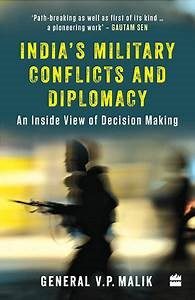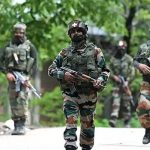
India’s defence and security strategy has been witnessing a major change. It is now gradually shifting its focus from preachy politics and reactive strategic posturing to a more robust and realist one. This change in India’s security policy is quite evident since the National Democratic Alliance (NDA) government under Prime Minister Narendra Modi came to power in 2014. V.P. Malik in the Preface of his book attempts to drive home the fact that India has now adopted a more disruptive and unpredictable approach in terms of its security policy. He highlights the same by citing examples of proactive operations such as the response of the Indian Army to the National Socialist Council of Nagaland in 2015, the Uri Special Forces strike in 2016 and the Balakot airstrike in 2019.
The author, General V.P. Malik was the Chief of the Indian Army from October 1997 to 2000. As Deputy Director-General, Military Operations, he dealt with the management of the border with China, Operation Pawan in Sri Lanka and Operation Cactus in the Maldives. Through the course of his book, he provides the readers with his own first-hand experiences during his long service in The Indian Army. There is a specific purpose to his historical account of some important strategic events, as the author believes that in India important decisions are rarely recorded in detail and then made public, this he attributes to either a culture of secrecy or simple procedural laziness. His book is an attempt to make the readers aware of the strategic scenario and the role of, political, diplomatic and military leadership in India. He provides detailed accounts of important strategic operations, as he firmly believes that there is a lot to learn from the conflict and decision making and execution of each of these operations. An interesting aspect of his account is his attempt to highlight the lacunae that exist between the military and those at the top of political decision making. This is a result of a feeling of apprehension about the Indian Army since the Nehruvian Era and the present bureaucratic control exerted over the armed forces.
The first chapter is a brief account of ‘Operation Pawan’, which was a codename assigned to the operation by the Indian Peace Keeping Force to enforce the disarmament of LTTE as part of the Indo-Sri Lankan Accord of 1987. The operation is a crisp example of wrong diplomatic and political handling. From the narrative presented by the author, it becomes clear that all political decisions were strictly kept in the domain of political/bureaucratic decision making and the army was ordered only to implement plans,to achieve political objectives. This resulted in a major communication gap between those who designed the plans and those who implemented them. The operation was unable to achieve its political objectives and there were approximately 1200 causalities suffered on part of the IPKF. Towards the end of the Chapter the author suggests that if the lack of politico-military consultations had been minimised, the IPKF would have suffered fewer casualties.
After providing an in-depth understanding of Operation Pawan and the tragic results it achieved, the author turns his attention towards ‘Operation Cactus,’1988, which in contrast was a quick commando action, where India’s armed forces foiled an attempt of an attempted coup in less than twenty-four hours. The Operation was India’s first rapid-reaction strategic mission at the request of a neighbour. According to the author, the success of the Operation can be attributed to the speed at which the decision to launch the operation was taken, after a brief assessment of the crisis in Malé, the then Prime Minister Rajiv Gandhi gave his approval for a joint services mission at the earliest. Furthermore, the swiftness in planning, mounting and executing the Operation was the chief battle winning factors.
The Third Chapter is an assessment of India’s rise as a nuclear power, in view of ‘Operation Shakti’, 1998. The Cold War period had highlighted the importance of nuclear deterrence as an important weapon in preventing the risk of an all-out war. Moreover, with the rise of China as a nuclear power in 1964, it became more than necessary for India to equip itself with nuclear weapons. In May 1998, the author recalls meeting up with the then Prime Minister Atal Bihari Vajpayee, the Principal Secretary Brajesh Mishra and Dr APJ Abdul Kalam, along with the other two service chiefs. The meeting was conducted to brief the three service chiefs regarding the nuclear tests that were to be conducted in Pokhran in the next few days and their role in the on-ground implementation of the Operation. The Chapter is certainly an enriching account of how India became a nuclear state, the author provides details of operational work such as the requirement to move the residents of the nearby village to a new location temporarily. Furthermore, it illustrates the international response that India received in terms of heavy sanctions from the USA, UK, Australia and Japan, which of course are history today. Lastly, the author points out the important facets of India’s nuclear doctrine which encompasses, ‘No First Use’ and ‘credible minimum deterrence.
Throughout the course of his book, the author highlights the lack of communication between civil and military leadership and how the military is often kept out of the decision-making loop. This stood true even for the nuclear decision-making process. Therefore, he calls for greater synergy between the two in case of a conflict and the need to have a direct politico-military interface.
An apt example of the success that can be achieved through such a direct interface was highlighted in the Kargil War of 1999. In his next chapter the author elucidates upon the strategic level decision making and execution of ‘Operation Vijay’. He begins by highlighting the early fog of the war wherein the Pakistani Army created a Mujahideen façade, the inability of Indian intelligence combined with weak surveillance in the region, was certainly a setback. However, once the initial fog was cleared with respect to the identity of the intruders (the Pakistan Army) the focus shifted away from counter-insurgency operations to the larger mobilization of the armed forces in order to seek a tactical advantage. This was highlighted by the decision of the Chief of Staff Committee (COSC) of implementing a joint strategy operational planning and action. Apart from the military planning, the political leadership exercised great restraint and made it clear that the Indian forces will not cross the LoC. This was done to keep the international opinion in India’s favour and to avoid conflict escalation in view of the recently acquired nuclear capabilities of both states. The conflict was an example of limited war and highlighted the success achieved by the Indian Armed Forces in clearing out the Pakistani Army from the Indian territory, this was largely a result of a politico-military interface and coordination among the armed forces.
The next chapter showcases an attempt by the author to highlight the expanding role of India’s Armed Forces, by focusing on the United Nation’s peacekeeping operations. India has been highly proactive in the maintenance of international peace and security and an important example of this is ‘Operation Khukri’, a multi-nation operation involving troops from India, Ghana, Nigeria and Britain. The operation was launched on 13 July 2000, to free 223 men of the 5/8 Gorkha Rifles kept hostage by the rebel forces. On 16 July, assisted by Mi-8 helicopters of the Indian Air Force and Army Aviation units, the operation was completed successfully with one fatal casualty and seven personnel who received splinter injuries. The operation is a successful example of synergy in the effort both at home as well as internationally.
The next chapter addresses the concept of ‘defence diplomacy’, which has emerged as a potent tool in achieving foreign policy objectives. Although India initially lacked behind in exploiting this tool of states craft, but in recent years it has been making considerable headway. The author highlights this by focusing upon India’s growing military cooperation with Maldives, US, Israel, China and Tajikistan. This sort of defence and military to military cooperation has paved the way for ensuring regional and global security. At the end of this chapter, the author suggests that the lack of a domestic industrial base is certainly a setback for India in terms of its capacity to supply arms. However, the reader can certainly relate to the recent ‘Make in India Initiative’ of the Indian Government and its implications for the defence sector, in terms of ensuring lesser dependence and greater self-reliance along with the ability to become a major future supplier.
The next two chapters provide an overview of India’s relations with its two prominent neighbours, Myanmar and Nepal. In the case of Myanmar, the author stresses the importance to put aside ideological considerations and the need to continue to maintain friendly relations with the state, keeping in mind India’s national interests. Hence, through his narrative, the author appears as a realist who primarily calls for a focus on national interests and not sentiment when it comes to strategy and diplomacy in international relations. He quotes Kautilya, who had emphasised the irrelevance of ethics in a scenario where the interests of countries are involved.
In case of Nepal, the author focuses on the deep roots of cultural linkages, common linguistic and ethnic identities between the two countries. He further elaborates upon the strong military cooperation that exists between the two states since the time of Maharaja Ranjit Singh of Nepal. It is important to note that despite political tensions between the two states, owing to the rise of China, the military cooperation between India and Nepal has remained strong. An important indicator of the same is the tradition of conferring the honorary rank of chief in each other’s army.
After providing a brief overview of decision making at the political and military level, during important strategic events, the author then turns his attention towards the organizational and attitudinal weaknesses in India’s higher defence management. First and foremost he highlights India’s commitment to moral values over realism in international politics. He suggests that this has resulted in the weakness of our strategic culture. In order to overcome the same, he calls for greater consciousness and awareness of defence and security at the level of our political leaders. Another major weakness in India’s defence management is the highly bureaucratised control over the military through civilian bureaucrats in the Ministry of Defence. This often results in a communication gap between the political and military leadership. In order to overcome this particular road bloc, the author calls for the greater interface between the political and military leadership, this can be ensured through greater involvement of the military in decision making with respect to national security issues.
The book by V.P. Malik is an enriching account of important strategic events in India’s military history. Most importantly, his work provides first-hand accounts of decision making at the politico-military level. The author truly has been successful in achieving his purpose of recording and sharing details of decision making during important strategic events. His recommendations towards the end of his book strongly highlight the need to adopt a holistic approach towards security and defence management and move beyond parochial interests. The author does come across as a firm realist with his emphasis on hard power- military and security of the state. Hence, if one were to take a more liberal approach, then there is a possibility of differences in opinions, with respect to India’s security concerns. However, his work provides a futuristic account of India’s defence management which might be useful keeping in view the changing security environment.













